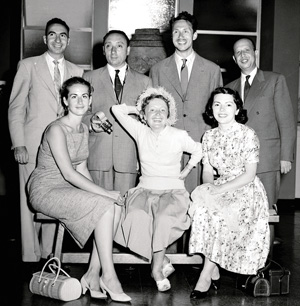Features & Columns
No Regrets: The Life of Edith Piaf
 LA VIE EN ROSICRUCIAN: In 1957, French singer Edith Piaf (center) visited her fellow esotericists at the Rosicrucian Museum in San Jose. ©2013 Supreme Grand Lodge, AMORC.
LA VIE EN ROSICRUCIAN: In 1957, French singer Edith Piaf (center) visited her fellow esotericists at the Rosicrucian Museum in San Jose. ©2013 Supreme Grand Lodge, AMORC.
In a flavor of synchronicity that now happens so often I consider it to be part of nature, two particular biographies simultaneously came into my zone of influence last month. For one, The Fractalist: Memoir of a Scientific Maverick (Pantheon), the posthumously published autobiography of Benoit Mandelbrot, arrived to remind me that disenfranchised academic researchers, those who carve their own paths outside the compartmentalized pigeonholes of established scientific fields, can eventually change the way we see the world.
Likewise, Carolyn Burke's book No Regrets: The Life of Edith Piaf (Knopf) sounded several notes, primarily that charismatic singers can rise from the slums and the abysses of alcohol and drugs to write their own lyrics, inspire other singers and thrill audiences worldwide. Turns out both Mandelbrot and Piaf spent parts of their childhood in the slum of Belleville, near Paris, and both visited San Jose at the heights of their careers.
Born in Warsaw in 1924 of Jewish Lithuanian descent, Mandelbrot overcame the horrors of World War II and was forced to relocate with his family twice before settling in southern France. The first third of The Fractalist documents those years, explaining how even though his uncle provided much guidance in his life, a certain outsider spirit and an uncontainable restlessness is what drove him.
In that sense, Mandelbrot describes his childhood as one surrounded by conflict and says that he never experienced long-term routines. Interruptions were the norm. He claims that his scientific destiny was a continuous search for a boundary-shattering problem, a "Kepler moment." Throughout his career, he seems more influenced by the academic outcasts and oddballs who crossed his path, as opposed to those who played politics within the system to remain safe.
A "general theory of roughness" as he calls it, is what resulted in the word "fractal," and once computers became fast enough, he discovered previously hidden laws of nature that no one else had cared to look for, viewable in shorelines, cauliflower heads, snowflakes, the economy and perhaps even his own career trajectory. As a result, he is now a household name.
Although not mentioned in the book, Mandelbrot did come to Silicon Valley in the late '80s, on a promo tour for a book edited by Heinz-Otto Peitgen. According to one source who was there, he bantered about feeling like a rock star, as he was often mobbed at his public appearances.
Like Mandelbrot, Edith Piaf was displaced by World War II, although the obstacles she overcame began directly as a result of a broken family situation. She either sang on the ruined streets of working-class Paris, boarded in a brothel or traveled with a circus freak show before eventually vaulting to stardom—all as a teenager.
As No Regrets explores in detail, Piaf wrote lyrics for more than 100 songs throughout her career, including several for other singers. The artist Jean Cocteau described her as an organism of "regal simplicity." When she performed, wrote Cocteau, Piaf had "the eyes of a blind person struck by a miracle, the eyes of a clairvoyant."
Spiritually, Piaf developed into an esotericist; she was an official dues-paying Rosicrucian for many years until her death. As the book observes, the American tune "Suddenly There's a Valley," when translated for Piaf, became "Soudain une vallee," with lyrics altered to reflect a Rosicrucian perspective.
What's more, a few pages later, the book notes that following several June 1957 performances at the San Francisco Fairmont, Piaf made a spiritual pilgrimage down the highway and through the hinterland to Rosicrucian Park in San Jose, where she was welcomed by her brothers and sisters.
Reading those two biographies at the same time—one male, one female—was a transformational experience, although it will be years before I figure out what any of it means. It seemed symbolic, as in ancient alchemy or Jungian psychology, when the androgynous union of opposites—male and female, yin and yang—emerged from an initial state of chaos to symbolize a magical synthesis and a more balanced situation. In this case, San Jose is the catalyzing third element, the fortifier that causes the alchemical transformation. Voila.


